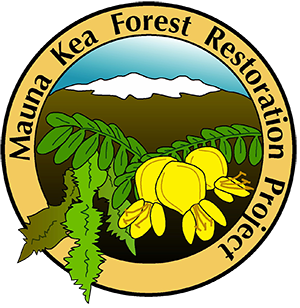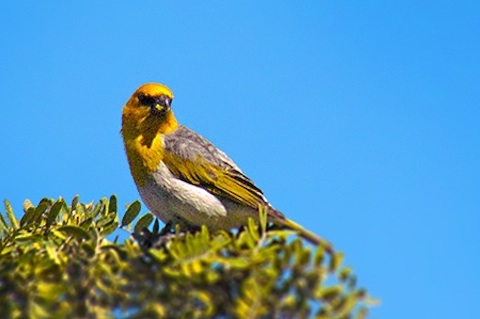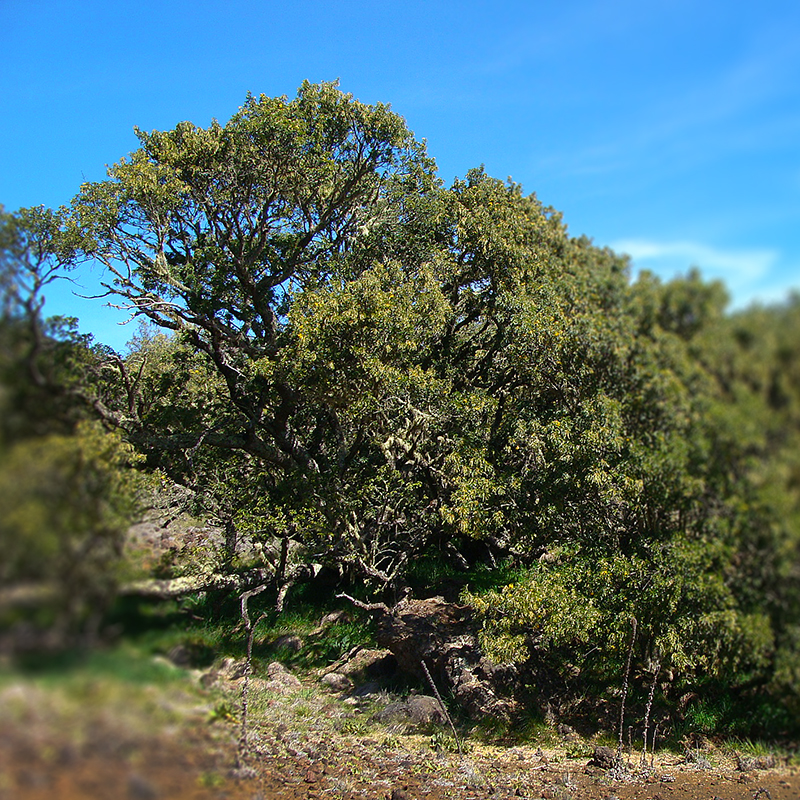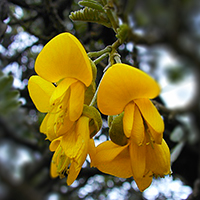Māmane
PALILA
(Loxioides bailleui)
Found only on the upper slopes of the largest mountain in the world, Mauna Kea, the critically endangered Palila has a vibrant yellow head, a strong bill, and a delightful call. This spectacular bird is an important part of our Hawaiian heritage worth protecting.
|
Māmane—food of the palila[three_fourth] Māmane (Sophora chrysophylla) is endemic to the Hawaiian Islands. It is the dominant tree in the high-elevation dry forest of Mauna Kea. Māmane is in the Fabaceae (pea and bean) family. It can grow in the form of either a large shrub or a tree with some trees over 40 feet tall. Bright yellow flowers grow on māmane produce pea pods. The seeds contain toxic chemicals called alkaloids. The elevational range of māmane has been reduced on both ends by human conversion of forest for agriculture and by nearly 200 years of browsing by non-native ungulates. It now occurs as low as 5,800 feet in some areas to above 10,000 feet at the highest elevations. Immature, green māmane seeds are the main component of the palila’s diet, although they also eat flowers and leaf buds. Native caterpillars found in the pods eating māmane seeds are protein-rich and an important food source for the quick-growing nestlings and fledglings. Māmane trees growing across a large elevational range are a good indicator of suitable palila habitat, and currently palila occur where the elevational distribution of the māmane forest is greatest. This is because māmane trees at lower elevations produce flowers and pods at one part of the year, and then later in the year trees at higher elevations produce flowers and pods. Thus, the result is a year round food supply—an important characteristic for a bird with a small home range.Māmane is the main tree of Mauna Kea’s high-elevation dry forest. It is said that the māmane would bloom in such quantities that from Hilo, it looked like Mauna Kea was adorned in a lei.
Traditional Hawaiian house complex often built with māmane wood. The hard, durable wood of māmane was used by the Native Hawaiians for pou (house posts) and kaola (beams) up to 2.0 in in diameter, ʻōʻō (digging sticks), ihe (spears), kope (spades), papa hōlua (sled) runners, papa olonā (Touchardia latifolia scrapers), ʻau koʻi (adze handles), and wahie (firewood). Cattle ranchers later used the wood as fence posts. Queen Emma names William Lindsey’s son in 1882“…when Queen Emma went to [Mauna Kea and the lake] Waiau, she told my father that she wanted my mother to go as well. My father told her, she was pregnant, pregnant with me. But she wanted a woman to accompany her…. Queen Emma told my father, ‘if a son is born, name him Ka-hale-lau-māmane’ {the māmane-leafed shelter}….[When they traveled up Mauna Kea,] they broke the māmane branch, and made a house. You can go hide underneath, and you donʻt get wet.” –James Kahalelaumāmane Lindsey, 1966; (excerpt from Mauna Kea, ka piko kaulana o ka ʻāina)
|




